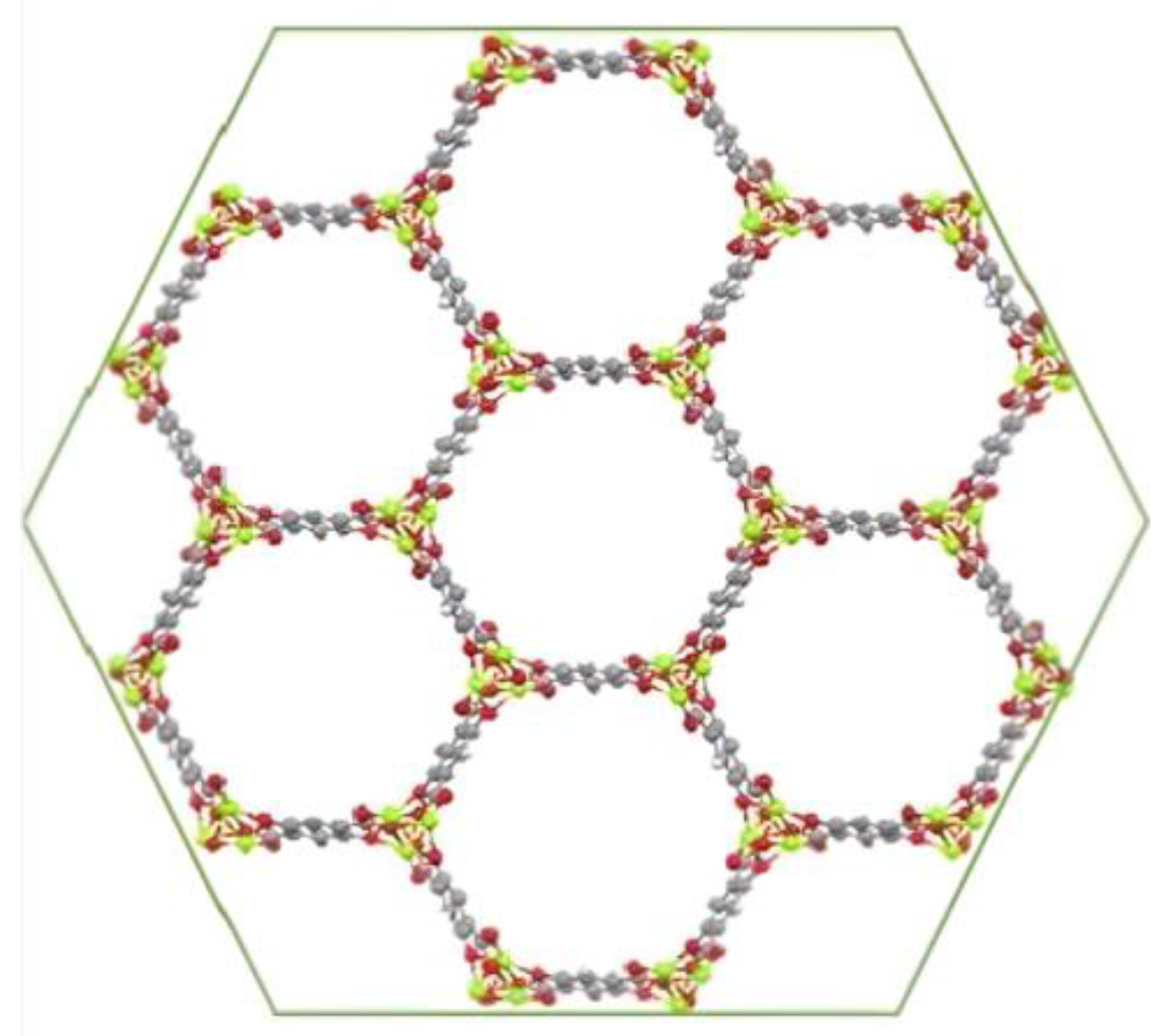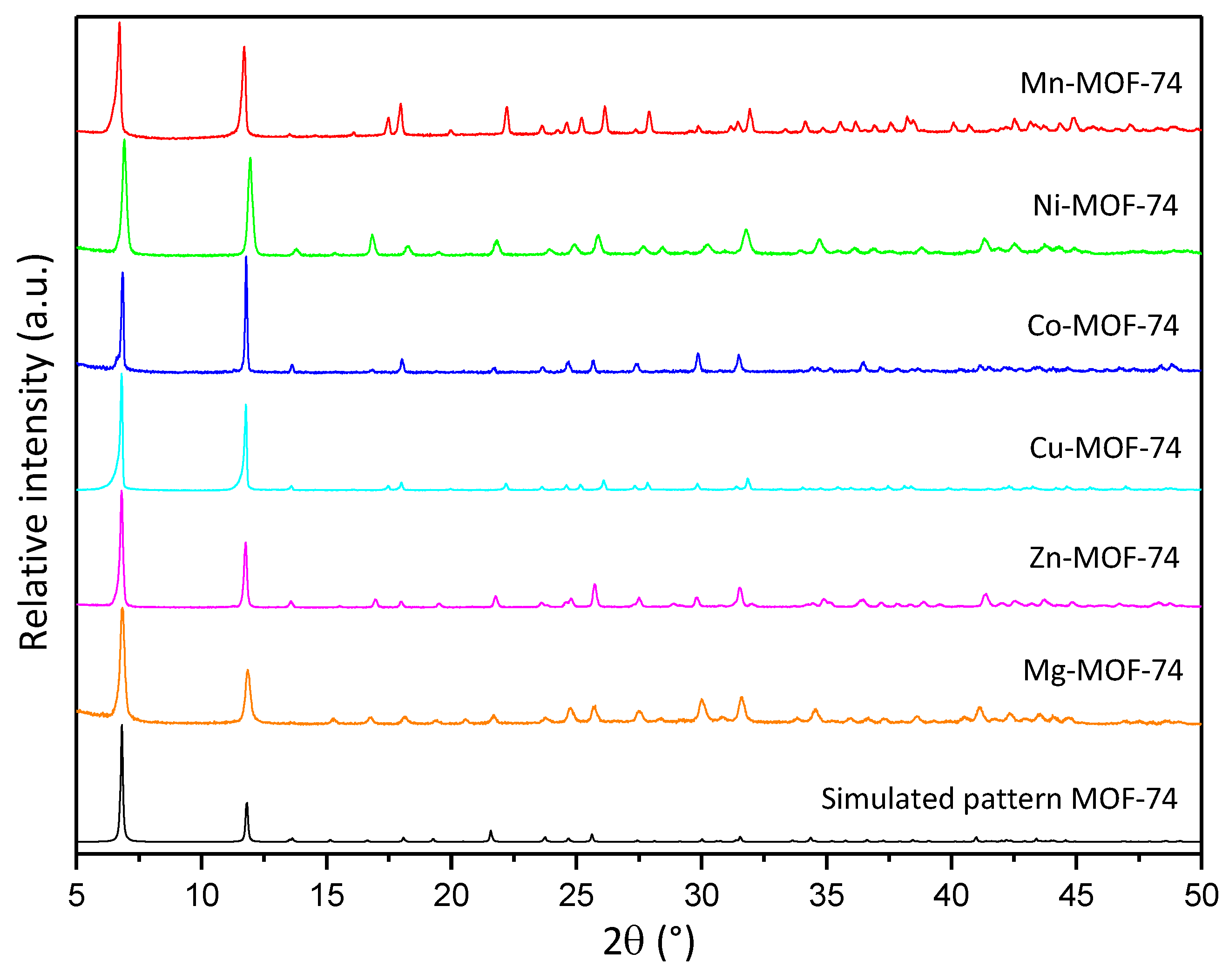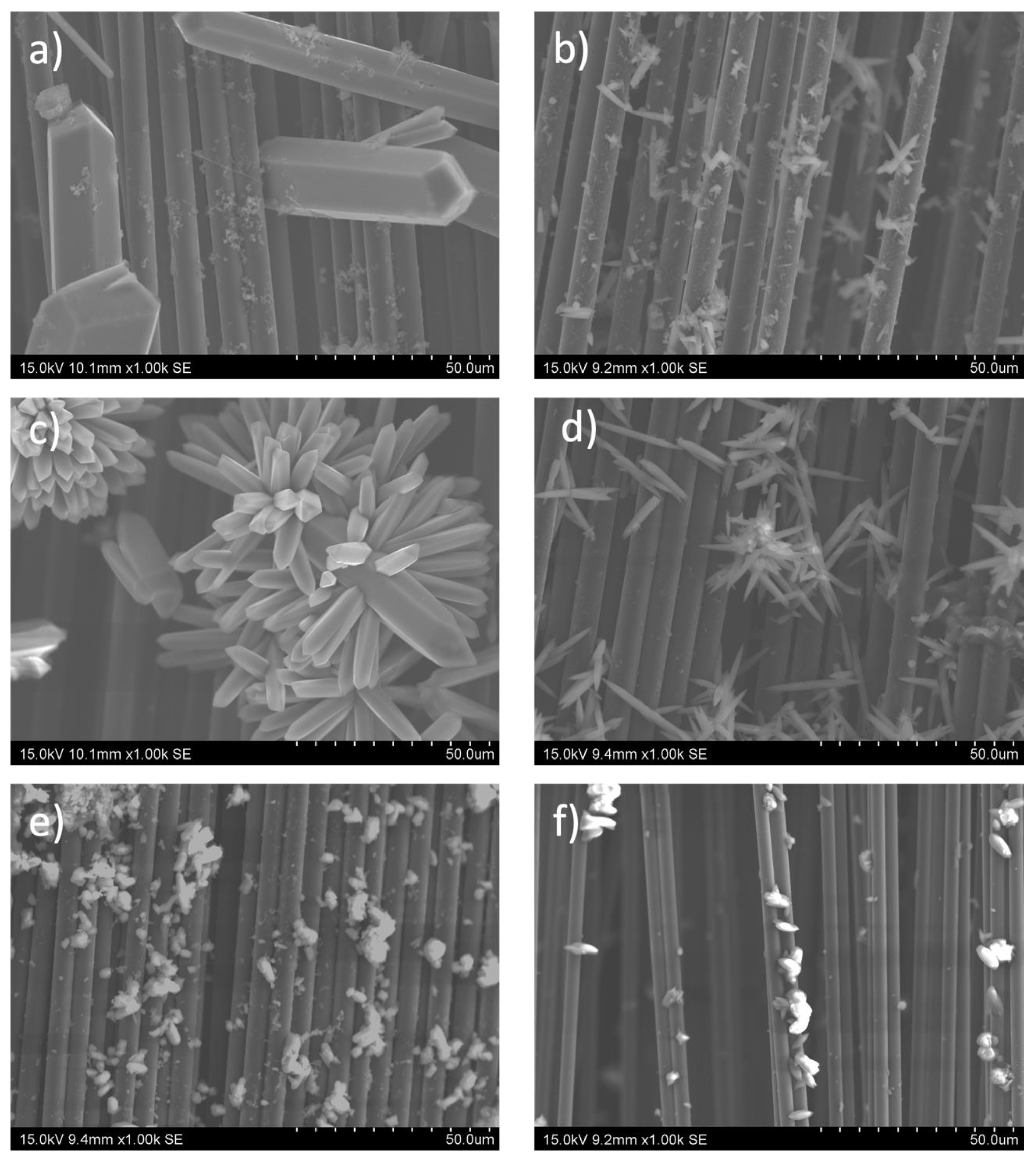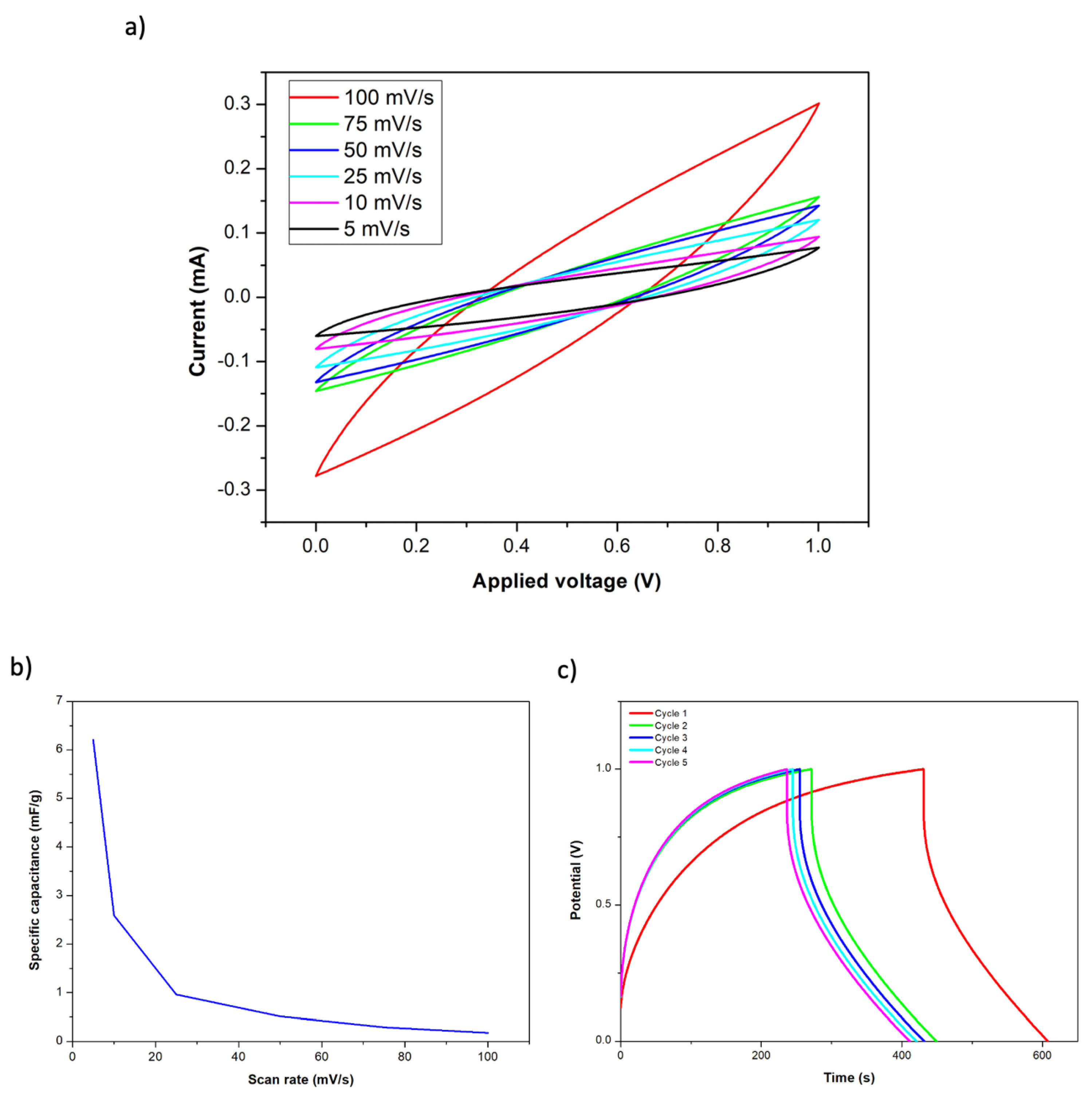Direct Synthesis of MOF-74 Materials on Carbon Fiber Electrodes for Structural Supercapacitors
Abstract
:1. Introduction
2. Materials and Methods
2.1. Preparation of Electrodes
2.2. Preparation of the Supercapacitors
2.3. Characterization
3. Results and Discussion
3.1. Characterization of MOF-74 Electrodes
3.2. Electrochemical Properties of MOF-74 Electrodes
3.3. Electrochemical Properties of Structural Supercapacitors
4. Conclusions
Supplementary Materials
Author Contributions
Funding
Data Availability Statement
Acknowledgments
Conflicts of Interest
References
- International Energy Agency. World Energy Outlook 2022. 2022. Available online: https://www.iea.org/reports/world-energy-outlook-2022?language=es (accessed on 7 September 2023).
- Ugurlu, A.; Oztuna, S. How liquid hydrogen production methods affect emissions in liquid hydrogen powered vehicles? Int. J. Hydrogen Energy 2020, 45, 35269–35280. [Google Scholar] [CrossRef]
- Ugurlu, A. An emission analysis study of hydrogen powered vehicles. Int. J. Hydrogen Energy 2020, 45, 26522–26535. [Google Scholar] [CrossRef]
- Sanguesa, J.A.; Torres-Sanz, V.; Garrido, P.; Martinez, F.J.; Marquez-Barja, J.M. A review on electric vehicles: Technologies and challenges. Smart Cities 2021, 4, 372–404. [Google Scholar] [CrossRef]
- Raccichini, R.; Varzi, A.; Passerini, S.; Scrosati, B. The role of graphene for electrochemical energy storage. Nat. Mater. 2015, 14, 271–279. [Google Scholar] [CrossRef] [PubMed]
- Cakici, M.; Reddy, K.R.; Alonso-Marroquin, F. Advanced electrochemical energy storage supercapacitors based on the flexible carbon fiber fabric-coated with uniform coral-like MnO2 structured electrodes. Chem. Eng. J. 2017, 309, 151–158. [Google Scholar] [CrossRef]
- Martinez-Diaz, D.; Leo, P.; Sanz, R.; Carrero, A.; Calles, J.A.; Alique, D. Life cycle assessment of H2-selective Pd membranes fabricated by electroless pore-plating. J. Clean. Prod. 2021, 316, 128229. [Google Scholar] [CrossRef]
- Xu, Y.; Xiao, M.; Liu, T.; Lin, R.; Meng, Y.; Zhang, Y.; Zhu, F. Nitrogen, boron and fluorine tri-doped carbon nanotubes on carbon cloth as the electrode materials for supercapacitors. J. Electroanal. Chem. 2023, 948, 117812. [Google Scholar] [CrossRef]
- Dunn, B.; Kamath, H.; Tarascon, J.-M. Electrical Energy Storage for the Grid: A Battery of Choices System power ratings, module size. Science 1979 2011, 334, 928–935. [Google Scholar] [CrossRef]
- Simon, P.; Gogotsi, Y. Materials for electrochemical capacitors. Nat. Mater. 2008, 7, 845–854. [Google Scholar] [CrossRef]
- Bograchev, D.A.; Volfkovich, Y.M.; Martemianov, S. Diagnostics of supercapacitors using cyclic voltammetry: Modeling and experimental applications. J. Electroanal. Chem. 2023, 935, 117322. [Google Scholar] [CrossRef]
- Arbizzani, C.; Yu, Y.; Li, J.; Xiao, J.; Xia, Y.Y.; Yang, Y.; Santato, C.; Raccichini, R.; Passerini, S. Good practice guide for papers on supercapacitors and related hybrid capacitors for the Journal of Power Sources. J. Power Sources 2020, 450, 1016. [Google Scholar] [CrossRef]
- Conway, B.E. Electrochemical Supercapacitors: Scientific Fundamentals and Technological Applications; Springer: New York, NY, USA, 1999. [Google Scholar] [CrossRef]
- Wang, L.; Han, Y.; Feng, X.; Zhou, J.; Qi, P.; Wang, B. Metal-organic frameworks for energy storage: Batteries and supercapacitors. Coord. Chem. Rev. 2016, 307, 361–381. [Google Scholar] [CrossRef]
- Xia, X.; Tu, J.; Zhang, Y.; Wang, X.; Gu, C.; Zhao, X.B.; Fan, H.J. High-quality metal oxide core/shell nanowire arrays on conductive substrates for electrochemical energy storage. ACS Nano 2012, 6, 5531–5538. [Google Scholar] [CrossRef] [PubMed]
- Roy, N.; Mangiri, R.; Phaneendra Reddy, G.; Manohar, A.; Chung, E.; Deva Prasad Raju, B.; Rajasekhara Reddy, G.; Woo Joo, S. Carbon nanofiber-supported elongated square bipyramid-like MnWO4 composite electrodes for high-performance battery-type supercapacitors: Enhanced electrochemical performance via synergistic effect. J. Electroanal. Chem. 2023, 947, 117764. [Google Scholar] [CrossRef]
- Cheng, F.; Yang, X.; Zhang, S.; Lu, W. Boosting the supercapacitor performances of activated carbon with carbon nanomaterials. J. Power Sources 2020, 450, 227678. [Google Scholar] [CrossRef]
- Liang, Y.; Liu, X.; Qi, X. Hierarchical nanoarchitectonics of ordered mesoporous carbon from lignin for high-performance supercapacitors. Int. J. Biol. Macromol. 2022, 213, 610–620. [Google Scholar] [CrossRef]
- Qiu, Y.; Wang, Z.; Jin, M.; Chen, J.; Miao, C.; Zhang, S.; Lai, L. Amorphous carbon interweaved mesoporous all-carbon electrode for wide-temperature range supercapacitors. Electrochim. Acta 2022, 424, 140622. [Google Scholar] [CrossRef]
- Li, W.; Wang, G.; Sui, W.; Xu, T.; Li, Z.; Parvez, A.M.; Si, C. Facile and scalable preparation of cage-like mesoporous carbon from lignin-based phenolic resin and its application in supercapacitor electrodes. Carbon N. Y. 2022, 196, 819–827. [Google Scholar] [CrossRef]
- Sánchez-Romate, X.F.; del Bosque, A.; Artigas-Arnaudas, J.; Muñoz, B.K.; Sánchez, M.; Ureña, A. A proof of concept of a structural supercapacitor made of graphene coated woven carbon fibers: EIS study and mechanical performance. Electrochim. Acta 2021, 370, 137746. [Google Scholar] [CrossRef]
- Artigas-Arnaudas, J.; Muñoz, B.K.; Sánchez, M.; de Prado, J.; Utrilla, M.V.; Ureña, A. Surface Modifications of Carbon Fiber Electrodes for Structural Supercapacitors. Appl. Compos. Mater. 2022, 29, 889–900. [Google Scholar] [CrossRef]
- Morenghi, A.; Scaravonati, S.; Magnani, G.; Sidoli, M.; Aversa, L.; Verucchi, R.; Bertoni, G.; Riccò, M.; Pontiroli, D. Asymmetric supercapacitors based on nickel decorated graphene and porous graphene electrodes. Electrochim. Acta 2022, 424, 140626. [Google Scholar] [CrossRef]
- Lv, S.; Ma, L.; Shen, X.; Tong, H. One-step copper-catalyzed synthesis of porous carbon nanotubes for high-performance supercapacitors. Microporous Mesoporous Mater. 2021, 310, 110670. [Google Scholar] [CrossRef]
- Kaushik, P.; Rastogi, C.K.; Channegowda, M.; Patel, A.; Gyanprakash, M. Investigating electrochemical properties of iron oxide-carbon nanotube composite for supercapacitor application. Mater Today Proc. 2023, 74, 324–328. [Google Scholar] [CrossRef]
- Raje, P.G.; Gurav, S.R.; Waikar, M.R.; Rasal, A.S.; Chang, J.Y.; Sonkawade, R.G. The review of different dimensionalities based pristine metal organic frameworks for supercapacitor application. J. Energy Storage 2022, 56, 105700. [Google Scholar] [CrossRef]
- Xie, X.X.; Yang, Y.C.; Dou, B.H.; Li, Z.F.; Li, G. Proton conductive carboxylate-based metal–organic frameworks. Coord. Chem. Rev. 2020, 403, 213100. [Google Scholar] [CrossRef]
- Wang, Y.C.; Li, W.B.; Zhao, L.; Xu, B.Q. MOF-derived binary mixed metal/metal oxide @carbon nanoporous materials and their novel supercapacitive performances. Phys. Chem. Chem. Phys. 2016, 18, 17941–17948. [Google Scholar] [CrossRef] [PubMed]
- Al-Furjan, M.S.H.; Shan, L.; Shen, X.; Zarei, M.S.; Hajmohamma, M.H.; Kolahchi, R. A review on fabrication techniques and tensile properties of glass, carbon, and Kevlar fiber reinforced rolymer composites. J. Mater. Res. Technol. 2022, 19, 2930–2959. [Google Scholar] [CrossRef]
- Peijs, T.; Kirschbaum, R.; Lemstra, P.J. Chapter 5: A critical review of carbon fiber and related products from an industrial perspective. Adv. Ind. Eng. Polym. Res. 2022, 5, 90–106. [Google Scholar] [CrossRef]
- Forintos, N.; Czigany, T. Multifunctional application of carbon fiber reinforced polymer composites: Electrical properties of the reinforcing carbon fibers—A short review. Compos. Part B 2019, 162, 331–343. [Google Scholar] [CrossRef]
- Yang, S.; Cheng, Y.; Xiao, X.; Pang, H. Development and application of carbon fiber in batteries. Chem. Eng. J. 2020, 384, 123294. [Google Scholar] [CrossRef]
- Leo, P.; Orcajo, G.; Briones, D.; Martínez, F.; Calleja, G. Direct α-arylation of ketones efficiently catalyzed by Cu-MOF-74. Catal. Today 2020, 345, 251–257. [Google Scholar] [CrossRef]
- Xie, L.S.; Skorupskii, G.; Dincǎ, M. Electrically Conductive Metal-Organic Frameworks. Chem. Rev. 2020, 120, 8536–8580. [Google Scholar] [CrossRef] [PubMed]
- Xie, S.; Qin, Q.; Liu, H.; Jin, L.; Wei, X.; Liu, J.; Liu, X.; Yao, Y.; Dong, L.; Li, B. MOF-74-M (M = Mn, Co, Ni, Zn, MnCo, MnNI, and MnZn) for low-temperature NH3-SCR and in situ Drifts study reaction mechanism. ACS Appl. Mater. Interfaces 2020, 12, 48476–48485. [Google Scholar] [CrossRef] [PubMed]
- Caskey, S.R.; Wong-Foy, A.G.; Matzger, A.J. Dramatic tuning of carbon dioxide uptake via metal substitution in a coordination polymer with cylindrical pores. J. Am. Chem. Soc. 2008, 130, 10870–10871. [Google Scholar] [CrossRef] [PubMed]
- Rowsell, J.L.C.; Yaghi, O.M. Effects of functionalization, catenation, and variation of the metal oxide and organic linking units on the low-pressure hydrogen adsorption properties of metal-organic frameworks. J. Am. Chem. Soc. 2006, 128, 1304–1315. [Google Scholar] [CrossRef] [PubMed]
- Abedini, H.; Shariati, A.; Khosravi-Nikou, M.R. Adsorption of propane and propylene on M-MOF-74 (M = Cu, Co): Equilibrium and Kinetic study. Chem. Eng. Res. Des. 2020, 153, 96–106. [Google Scholar] [CrossRef]
- del Bosque, A.; Muñoz, B.K.; Sánchez, M.; Ureña, A. Thermomechanically Robust Ceramic/Polymer Nanocomposites Modified with Ionic Liquid for Hybrid Polymer Electrolyte Applications. ACS Appl. Energy Mater. 2022, 5, 4247–4258. [Google Scholar] [CrossRef]
- Zuluaga, S.; Fuentes-Fernandez, E.M.A.; Tan, K.; Xu, F.; Li, J.; Chabal, Y.J.; Thonhauser, T. Understanding and controlling water stability of MOF-74. J. Mater. Chem. A Mater. 2016, 4, 5176–5183. [Google Scholar] [CrossRef]
- Kökçam-Demir, Ü.; Goldman, A.; Esrafili, L.; Gharib, M.; Morsali, A.; Weingart, O.; Janiak, C. Coordinatively unsaturated metal sites (open metal sites) in metal-organic frameworks: Design and applications. Chem. Soc. Rev. 2020, 49, 2751–2798. [Google Scholar] [CrossRef]
- Dhandapani, E.; Thangarasu, S.; Ramesh, S.; Ramesh, K.; Vasudevan, R.; Duraisamy, N. Recent development and prospective of carbonaceous material, conducting polymer and their composite electrode materials for supercapacitor—A review. J. Energy Storage 2022, 52, 104937. [Google Scholar] [CrossRef]
- Kim, H.; Hong, C.S. MOF-74-type frameworks: Tunable pore environment and functionality through metal and ligand modification. CrystEngComm 2021, 23, 1377–1387. [Google Scholar] [CrossRef]
- Xu, L.; Jiang, A.; Yang, Z.; Guan, H.; Jia, H.; Min, M. Mechanical properties of CFF/MC/SF composite prepared using vacuum infusion impregnation method. Results Phys. 2017, 7, 1016–1021. [Google Scholar] [CrossRef]
- Díaz-García, M.; Mayoral, Á.; Díaz, I.; Sánchez-Sánchez, M. Nanoscaled M-MOF-74 materials prepared at room temperature. Cryst. Growth Des. 2014, 14, 2479–2487. [Google Scholar] [CrossRef]
- Elgrishi, N.; Rountree, K.J.; McCarthy, B.D.; Rountree, E.S.; Eisenhart, T.T.; Dempsey, J.L. A Practical Beginner’s Guide to Cyclic Voltammetry. J. Chem. Educ. 2018, 95, 197–206. [Google Scholar] [CrossRef]
- Yang, L.; Zhu, Q.; Yang, K.; Xu, X.; Huang, J.; Chen, H.; Wang, H. A Review on the Application of Cobalt-Based Nanomaterials in Supercapacitors. Nanomaterials 2022, 12, 4065. [Google Scholar] [CrossRef] [PubMed]
- Vadivel, S.; Naveen, A.N.; Theerthagiri, J.; Madhavan, J.; Priya, T.S.; Balasubramanian, N. Solvothermal synthesis of BiPO4 nanorods/MWCNT (1D-1D) composite for photocatalyst and supercapacitor applications. Ceram. Int. 2016, 42, 14196–14205. [Google Scholar] [CrossRef]
- Jadhav, S.; Kalubarme, R.S.; Suzuki, N.; Terashima, C.; Kale, B.; Gosavi, S.W.; Ashokkumar, M.; Fujishima, A. Probing electrochemical charge storage of 3D porous hierarchical cobalt oxide decorated rGO in ultra-high-performance supercapacitor. Surf. Coat. Technol. 2021, 419, 127287. [Google Scholar] [CrossRef]
- Xu, Z.; Younis, A.; Chu, D.; Ao, Z.; Xu, H.; Li, S. Electrodeposition of mesoporous Co3O4 nanosheets on carbon foam for high performance supercapacitors. J. Nanomater. 2014, 2014, 902730. [Google Scholar] [CrossRef]
- Li, R.; Shen, Z.; Zheng, H.; Jin, L.; Zhang, Y.; Yuan, W.; Wang, X. Three-dimensional nitrogen and oxygen co-doped hierarchical porous carbons prepared from polyacrylonitrile/polyamic acid composite films for supercapacitors. J. Energy Storage 2023, 73, 109521. [Google Scholar] [CrossRef]
- Wang, X.; Fei, Y.; Chen, J.; Pan, Y.; Yuan, W.; Zhang, L.Y.; Guo, C.X.; Li, C.M. Directionally In Situ Self-Assembled, High-Density, Macropore-Oriented, CoP-Impregnated, 3D Hierarchical Porous Carbon Sheet Nanostructure for Superior Electrocatalysis in the Hydrogen Evolution Reaction. Small 2022, 18, 2103866. [Google Scholar] [CrossRef]





| Material | Solvent | Metal Source (mmol) | Organic Ligand (mmol) | Temperature (°C) | Time (h) | Ref. |
|---|---|---|---|---|---|---|
| Mn-MOF-74 | 25 mL 15DMF:1ethanol:1H2O | MnCl2·6H2O 1.111 | 0.366 | 135 | 24 | [35] |
| Ni-MOF-74 | 20 mL 1DMF:1ethanol:1H2O | Ni(NO3)2·6H2O 0.818 | 0.241 | 100 | 24 | [36] |
| Co-MOF-74 | 20 mL 1DMF:1ethanol:1H2O | Co(NO3)2·6H2O 0.867 | 0.243 | 100 | 24 | [36] |
| Cu-MOF-74 | 25 mL 20DMF:1isopropanol | Cu(NO3)2·3H2O 1.119 | 1.119 | 80 | 18 | [33] |
| Zn-MOF-74 | 25 mL 20DMF:1H2O | Zn(NO3)2·4H2O 0.729 | 0.243 | 100 | 20 | [37] |
| Mg-MOF-74 | 25 mL 15DMF:1ethanol:1H2O | Mg(NO3)2·6H2O 0.926 | 0.280 | 125 | 20 | [36] |
| Material | SBET (m2/g) | Vp (cm3/g) |
|---|---|---|
| Mn-MOF-74 | 867 | 0.43 |
| Ni-MOF-74 | 1121 | 0.49 |
| Co-MOF-74 | 1127 | 0.54 |
| Cu-MOF-74 | 1126 | 0.55 |
| Zn-MOF-74 | 995 | 0.44 |
| Mg-MOF-74 | 710 | 0.43 |
| Supercapacitor Charging Time (min) | LED Lighting Time (min) |
|---|---|
| 1 | 4 |
| 5 | 11 |
| 15 | 19 |
| 30 | 38 |
Disclaimer/Publisher’s Note: The statements, opinions and data contained in all publications are solely those of the individual author(s) and contributor(s) and not of MDPI and/or the editor(s). MDPI and/or the editor(s) disclaim responsibility for any injury to people or property resulting from any ideas, methods, instructions or products referred to in the content. |
© 2024 by the authors. Licensee MDPI, Basel, Switzerland. This article is an open access article distributed under the terms and conditions of the Creative Commons Attribution (CC BY) license (https://creativecommons.org/licenses/by/4.0/).
Share and Cite
Martinez-Diaz, D.; Leo, P.; Crespo, D.M.; Sánchez, M.; Ureña, A. Direct Synthesis of MOF-74 Materials on Carbon Fiber Electrodes for Structural Supercapacitors. Nanomaterials 2024, 14, 227. https://doi.org/10.3390/nano14020227
Martinez-Diaz D, Leo P, Crespo DM, Sánchez M, Ureña A. Direct Synthesis of MOF-74 Materials on Carbon Fiber Electrodes for Structural Supercapacitors. Nanomaterials. 2024; 14(2):227. https://doi.org/10.3390/nano14020227
Chicago/Turabian StyleMartinez-Diaz, David, Pedro Leo, David Martín Crespo, María Sánchez, and Alejandro Ureña. 2024. "Direct Synthesis of MOF-74 Materials on Carbon Fiber Electrodes for Structural Supercapacitors" Nanomaterials 14, no. 2: 227. https://doi.org/10.3390/nano14020227






